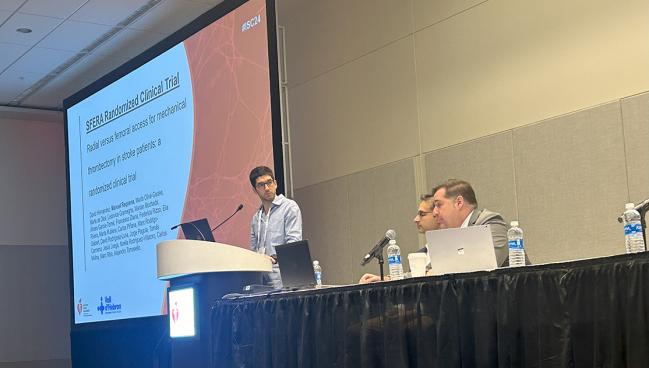Radial Access for Acute Stroke Interventions Takes Longer, No Safety Gains
Whether that delay versus transfemoral access has an impact on patient outcomes remains a key question.

PHOENIX, AZ—Among patients with acute ischemic stroke, going through the radial artery for mechanical thrombectomy is noninferior to using transfemoral access when it comes to recanalization and has similar safety, the single-center randomized SFERA trial showed.
Radial access does take longer, however.
The median time between arrival at the angiography suite and first pass with the thrombectomy device was 11 minutes longer, and the time to recanalization was extended by about 18 minutes, Manuel Requena, MD, PhD (Hospital Universitari Vall d’Hebron, Barcelona, Spain), reported last week at the International Stroke Conference. The findings also were published online in Stroke.
It’s possible that the added time needed for transradial access could be lessened by skipping ultrasound and the micropuncture set used to gain access in the wrist, which would have uncertain effects on safety, or by using radial access for a greater number of elective cases to gain more experience, Requena said.
Something to consider, however, is that there is less use of antiplatelets and anticoagulants in the setting of neurovascular interventions than in coronary interventions, he added, which might increase the likelihood of radial occlusion and reduce the risk of femoral bleeding. The implication is that the advantages of radial versus femoral access observed in the coronary space may be diminished when treating patients with acute stroke, making any delays in treatment less acceptable.
In my experience, in my center, I think that transfemoral is the future. Manuel Requena
“We have followed cardiologists in a lot of things in our field and probably this is another [area] that we will explore in the future,” Requena said after his presentation. But treatment delays are more important for neurovascular interventions, and it might take some time to close the gap between radial and femoral access, an effort that would be worth it only if radial is shown to be safer, he said.
“In my experience, in my center, I think that transfemoral is the future,” Requena said.
The SFERA Trial
Although the use of radial access has received strong recommendations in guidelines for the management of coronary disease, femoral access is still the predominant method for stroke interventions. Radial access in this setting remains controversial, with mixed results coming from retrospective studies.
To provide some randomized data, Requena and colleagues initiated the SFERA trial at their center, where operators experienced in radial access perform about 300 thrombectomies each year. They randomized 120 patients with acute ischemic stroke caused by a large-vessel occlusion to mechanical thrombectomy via the transradial or the transfemoral approach. All patients had a patent femoral artery and a radial artery with a diameter of at least 2.5 mm. In all, 116 patients (median age 76; 50.9% men) with a confirmed intracranial occlusion on the initial angiogram were included in the intention-to-treat analysis.
The primary outcome was successful recanalization (eTICI 2b-3 reperfusion) adjudicated by blinded evaluators. This was achieved by 87.9% of patients treated via the femoral approach and 96.6% of those treated via the radial approach. The adjusted risk difference was -5.0% (95% CI -6.61%-13.1%), establishing noninferiority of the radial approach using a margin of -13.2%. Results were similar in a per-protocol analysis.
Going through the wrist took longer, however, with greater median times from:
- Angio suite arrival to first pass of the thrombectomy device (41 vs 30 min; P < 0.001)
- Angio suite arrival to recanalization (60 vs 42 min; P < 0.05)
- Puncture to first pass (26 vs 20 min; P = 0.005)
- Puncture to recanalization (50 vs 32 min; P = 0.072)
There were no differences in the number of passes, use of conscious sedation, thrombectomy technique, proportion of patients with a final eTICI 2c-3, vascular access conversion, or median modified Rankin Scale score.
In terms of safety, overall vascular complications were numerically more frequent in the radial group (10.3% vs 1.7%; P = 0.051), driven by asymptomatic radial occlusion, Requena said. There was one severe access-site complication in each arm of the trial: a patient in the femoral group died from a retroperitoneal hemorrhage and a patient in the radial group had a symptomatic radial occlusion that required surgery.
Every minute of delay in treatment of the brain counts—millions of neurons die. Nestor Gonzalez
Symptomatic intracranial hemorrhage occurred in four patients in each group. Patients treated via the femoral approach had numerically higher rates of in-hospital mortality (17% vs 7%; P = 0.400) and procedural complications (8.6% vs 3.4%; P = 0.402), although the study was not powered to detect statistically significant differences in safety.
The Importance of Time in Acute Stroke
Commenting for TCTMD, Nestor Gonzalez, MD (Cedars-Sinai Medical Center, Los Angeles, CA), chair of the Stroke Neurovascular Intervention Committee within the American Heart Association’s Stroke Council, welcomed having a randomized trial exploring the impact of transradial access in acute stroke interventions.
There has been some optimism about the use of radial access for neurovascular interventions based on the good results seen in the cardiac space, but, Gonzalez said, “having specific studies is essential because there are fundamental differences in the geometry of the approach.”
Although this study shows that there were similar rates of recanalization irrespective of the type of vascular access used, the transfemoral approach was significantly faster. And that is a key consideration, because for stroke management, “time is essential,” Gonzalez said. “Every minute of delay in treatment of the brain counts—millions of neurons die.”
Whether the time gaps observed in SFERA translate into differences in patient outcomes remains to be seen, he said. He added, however, that “the timing needs to be reduced or somebody needs to show that the timing is not important anymore, which I doubt would ever happen because timing is essential in the management of stroke.”
One question, Gonzalez said, is why operators should use transradial access when transfemoral works already, particularly when—as shown in this study—serious complications are comparable with the two approaches. In the realm of neurovascular interventions, there may be room for radial access—in elective cases that require anticoagulation and time is not as critical, for instance—but the need to switch to a new access type and the benefit to patients still must be addressed, he said.
Additional studies of radial access conducted across multiple centers could be interesting, said Gonzalez, highlighting the need to assess the impact on patient outcomes. “If the delay [with radial access] is affecting their functional outcomes and rates of complications are comparable, then maybe for ischemic stroke the transfemoral pathway should continue being the predominant way.”
Todd Neale is the Associate News Editor for TCTMD and a Senior Medical Journalist. He got his start in journalism at …
Read Full BioSources
Hernandez D, Requena M, Olivé-Gadea M, et al. Radial versus femoral access for mechanical thrombectomy in stroke patients: a randomized clinical trial. Stroke. 2024;Epub ahead of print.
Disclosures
- Requena reports receiving personal fees for consulting for Anaconda Biomed.





Ian Gilchrist